In the following posts we’ll tell you about some great hikes, great road bicycling and inexpensive primitive camping in Southwest Colorado.
Our summer travels begin near Pagosa Springs. There are two
good primitive National Forest campgrounds in the area that suit our style of
camping. They’re great places to camp if you want to visit Pagosa Springs but
not be in the middle of this congested and tightly packed community at its summer peak. You can
visit the town, catch the excitement and go back to a quiet forest camp.
East Fork San Juan River, San Juan National Forest. We
stayed two nights at the East Fork Campground. This is a primitive Forest
Service campground north of Pagosa Springs in a dense stand of fir and aspen about a mile off Highway
60 on a good gravel road. There are picnic
tables, fire pits, vault toilets and limited cellular data coverage. It’s $20/night, $10 with
Senior Pass.
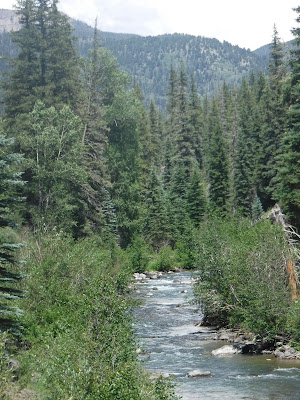 |
| East Fork San Juan River. |
From this campground we could hike two trails, Quartz Ridge and Coal Creek, that begin at a trailhead about
three miles upriver from the campground at the confluence of the East Fork and Sand
Creek. The gravel road continued to be good and we could easily drive to the
trailhead from the campground.
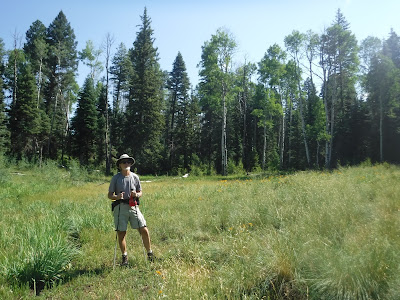 |
| Jim on the Quartz Ridge Trail. |
Quartz Ridge Trail, South
San Juan Wilderness. The trail climbs steeply but once on the ridge became gradual.
Lots of dead fall from the previous
winter slowed our progress. The trail meandered across sunny, sloping meadows
and through gorgeous green aspen stands before dropping back down to Sand
Creek. We stopped for lunch at the 3 mile point then decided to turn back.
 |
| Jim hiking through a sunny meadow on the Quartz Ridge Trail. |
 |
| A view from the Quartz Ridge Trail. |
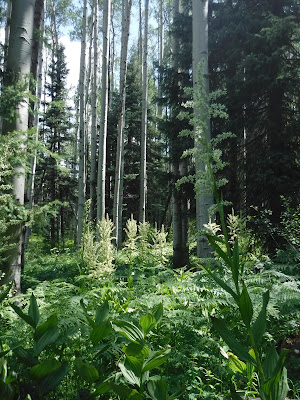 |
| Aspen and California Corn Lily. |
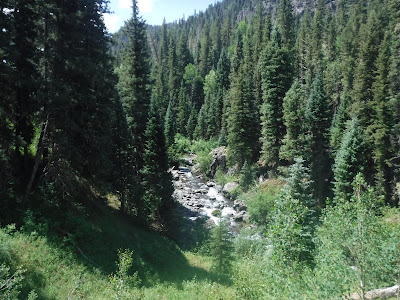 |
| Sand Creek from the Quartz Ridge Trail. |
 |
| Jackie hiking through the Aspens on the Quartz Ridge Trail. |
 |
| Aspen and Bracken Fern along the Quartz Ridge Trail. |
 |
Jim and a little Golden-mantled Ground Squirrel. The little guy didn't twitch a tail the
entire time we stood there. He thought he was hiding. |
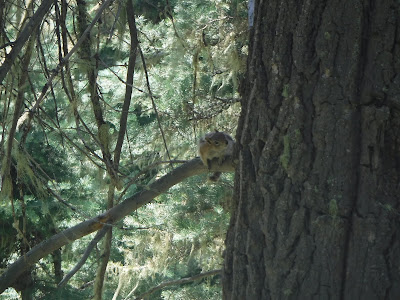 |
| A Golden-mantled Ground Squirrel plays hide & seek with Jim. |
By one o’clock clouds unfurled over the mountains and the
grumblings of a thunderstorm began. Rain misted the peaks but we only got a few
drops before we got back to the van.
The overcast gloomed and cooled the afternoon much to the
approval of the Hermit Thrush. As we walked down the mountain the forest chimed
with their silver fluting tremolo. The six mile hike took us about 4.5 hours
but we were leisurely and stopped often for pictures.
 |
| East Fork San Juan River, opportunities for fly fishing for native Browns. |
On our drive to the trailhead we saw lots of boon dock sites
along the East Fork and decided to move our camp closer to the trailhead to hike the Coal Creek Trail the next day. We found a great boon dock site along the
river just above the confluence with Sand Creek and stayed two nights. The East Fork and Sand Creek offer great fly fishing for native Brown Trout.
 |
| Coal Creek Trail. |
The Coal Creek Trail was very steep with an altitude gain of
1500 ft. in three miles. We hiked three miles up the ridge and
turned around when we saw afternoon storms percolating on the peaks.
 |
| Looking at the Continental Divide from Coal Creek Trail. |
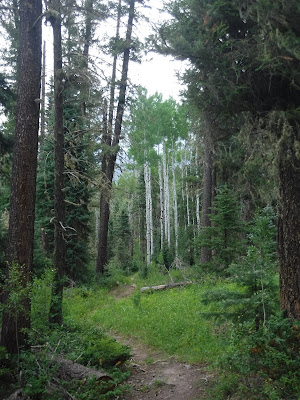 |
| Serene Aspen stands on the Coal Creek Trail. |
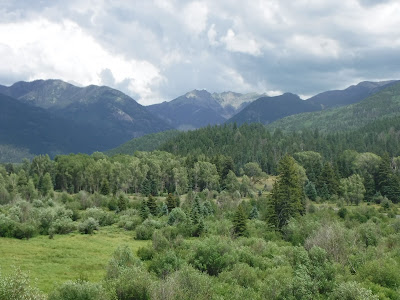 |
| Looking up the East Fork to Elwood Pass, a popular destination for 4-wheel drive vehicles. |
The road is heavily used by 4-wheel drive vehicles and OHV’s to access the high
country and drive to Elwood Pass on the Continental Divide. A few miles
above the confluence of the East Fork and Sand Creek the road is labeled as
4-wheele drive.
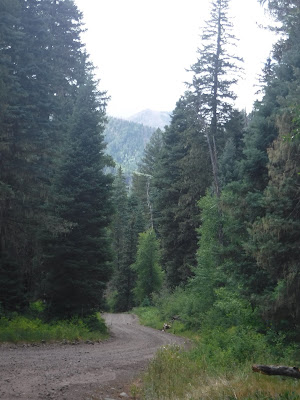 |
| The road to West Fork Campground. |
 |
| West Fork San Juan River near the West Fork Campground. |
West Fork Campground, San Juan National Forest. We moved to West Fork Campground only a few miles away. It’s another primitive Forest Service campground but has a water tap. It’s about 3 miles of good gravel road to get to the campground. The cost is $20/night, $10 with Senior Pass. The campground is a peaceful among tall pines and aspen. There's a good hike to a hot spring on the Rainbow Trail but we didn't take time to do it. We only stayed overnight so we could fill our water tank and head over Wolf Creek Pass for Creede in the upper Rio Grande River basin.
 |
| Our camp at Lost Trail Creek. One of our favorites. |
Lost Trail Creek Campground, Rio Grande National Forest. We camped two nights at the Lost Trail Creek
Campground, a primitive Forest Service campground that has picnic tables, fire
pits, vault toilet, outstanding scenery and no fee. It’s near the Rio Grande River a couple miles
above the Rio Grande Reservoir at over 9,000 feet in elevation.
 |
| A view from our camp at Lost Trail Creek. |
 |
| Lost Trail Creek. |
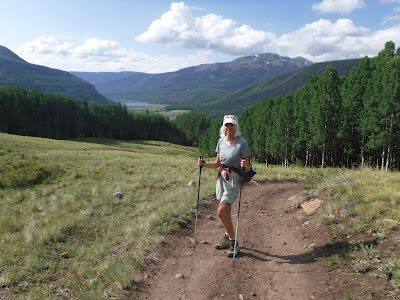 |
Hiking on Lost Trail Creek trail. The first two miles were an OHV trail.
The Rio Grande Reservoir in the distance. |
Thirty years ago when we were somewhat younger we staged an
8-day backpack trip beginning at the Lost Trail Creek trailhead. We hiked up to
the Continental Divide Trail and followed it around the headwaters of the Rio
Grande. We wanted to do a day hike on this same trail again and revisit this
beautiful country. The big surprise was that the first two miles of Lost Trail Creek trail had been converted to an OHV trail. Several groups of off-roaders passed us as we hiked.
 |
| Volcanic formations along the Lost Trail Creek. |
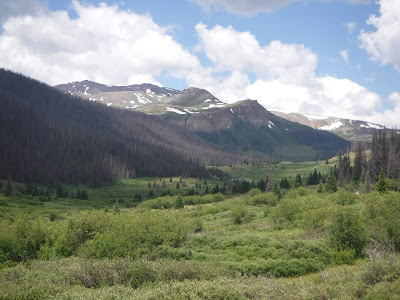 |
| Lookin up West Fork Lost Trail Creek. No OHV's allowed. |
 |
| West Fork Lost Trail Creek. |
 |
| Beaver ponds on the West Fork Lost Trail Creek. |
In two miles we intersected the trail for West Fork
Lost Trail Creek. This trail is designated for hiking, mountain bikes and trail
bikes only. We saw no one else and had a wonderful hike up the canyon.
Clouds accumulate during the day leading to afternoon showers so always take
rain gear. We got a light shower and small hail at noon but it only lasted
about 15 minutes. You never can tell.
 |
| Wildflowers along West Fork Lost Trail Creek. |
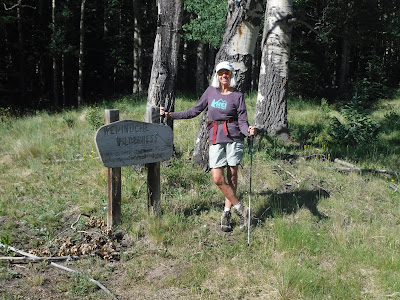 |
| Ute Creek Trailhead in the Weminuche Wilderness, Rio Grand National Forest. |
 |
| The trail passes through fir and aspens. |
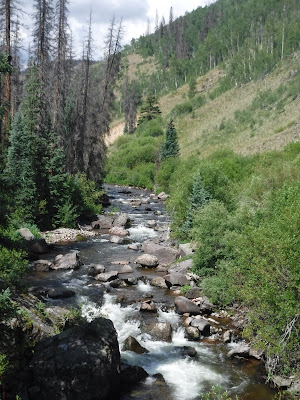 |
| Ute Creek. |
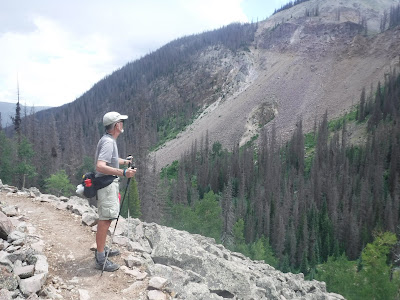 |
| Jim on the Ute Creek Trail. |
The trail contours
for several miles around the upper end of the reservoir then ascends gradually
up the canyon. It’s an easy and beautiful hike through aspen and spruce. In about
3.5 miles we descends to Ute Creek. The canyon broadens and beaver
dams and lodges fill the valley floor.
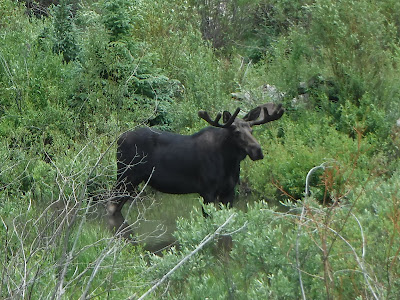 |
| A handsome bull Moose at the beaver ponds. |
We were thrilled to see two Moose at the beaver ponds. Moose were introduced into the area in the early 1990's.
 |
| "Who goes there?" We get the attention of a young Moose. |
 |
| The young Moose turns shy and disappears into the willow. |
This is a wonderful hike and not too strenuous. At about 4.5 miles the trail begins to climb to a Granite Lake. We turned around at the 5-mile point as thunder rumbled and rain
began to fall on the peaks.
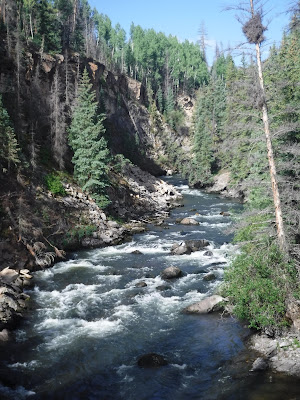 |
| The Rio Grand River at 30-Mile Campground below the Rio Grand Reservoir dam. |
30-mile Campground at Rio Grande Reservoir in the Rio Grande
National Forest. We spent three nights here. The campground is just below the
Rio Grande Reservoir dam. It has water at taps and the cleanest, homiest vault
toilets we’ve ever seen. The cost is $18/night, $9 with Senior Pass. The Rio Grande flows past the campground and has
fishing access. I forgot to take a photo of our camp but there are many nice campsite in trees or in clearings.
Two trails, the Weminuche Pass Trail and the Squaw Creek Trail,
begin from here. We hiked both these trails in the 1980’s on another
backpacking trip on the CDT. Weninuche Pass was our entry and Squaw Creek was
our exit.
 |
| The Weminuche Wilderness boundary is about a half mile from the campground on the Weminuche Pass trail. |
Weminuche Pass Trail. On the first day at 30-Mile Campground we hiked to Weminuche
Pass, about a 10.5 mile round trip.
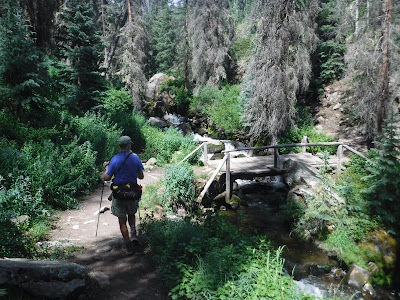 |
| A foot bridge crosses Weminuche Creek on the Weminuche Pass trail. |
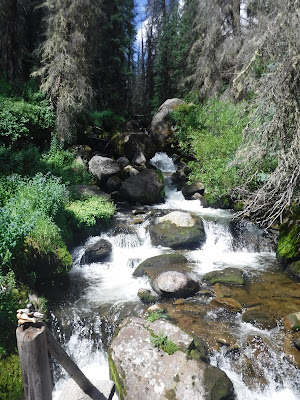 |
| Looking up Weminuche Creek from the bridge. |
The trail contours along the reservoir for about two miles
to a picturesque foot bridge crossing Weminuche Creek where it tumbles down the
gorge. After the bridge the trail climbs steeply to get above the gorge to a
broad valley.
 |
| Looking up the valley to Weminuche Pass. |
The hiking is easy on the gradual ascent to the pass. It meanders
through spruce and aspen stands above the slopping valley floor so there is
plenty of shade interspersed with grassy slopes. It’s about six miles to the
pass which is a great day hike destination but we turned around about a half
mile short of our goal due to a late start.
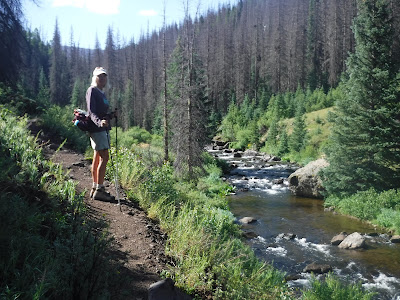 |
| Jackie on the Squaw Creek Trail. |
Squaw Creek Trail. On our 2nd day we hiked up Squaw
Creek. The trail begins with a climb to the top of a gorge. After crossing the
creek on a foot bridge it climbs above the creek and follows high on the slope
through spruce and aspen. In about two miles the canyon opens into a high
valley where the trail becomes more gradual. Fly fishermen hike up to this
valley hoping for native brown and brook trout.
 |
| A falls on Squaw Creek. |
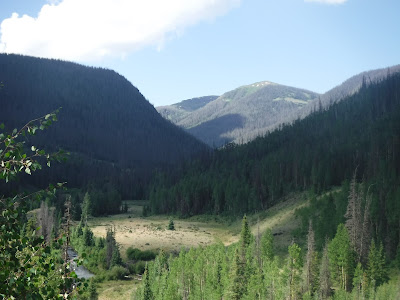 |
| Looking up Squaw Creek to the Continental Divide. |
The trail through the valley is open and sun exposure at an
elevation of over 9,000 ft. can be dehydrating and exhausting. Be sure to have
sun screen and plenty of extra water or bring a water filter or treatment to
get water from the creek or numerous springs along the trail.
It’s seven miles from the campground to the foot
bridge at the upper end of the valley where the trail ascends to Squaw Lake and
the CDT. It’s a nice day hike destination for hikers with an early start. If
you’re not used to the altitude it can be a bridge too far.
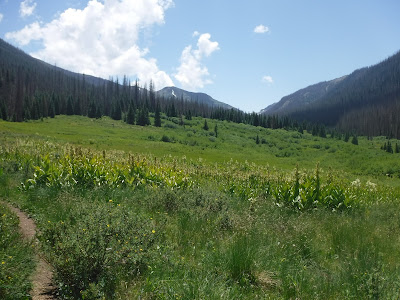 |
| The upper portion of Squaw Creek is in open country with little shade. The sun can be very intense without cloud cover. |
We turned around at 5.5 miles when we got to a point that we
could see the peaks along the Continental Divide. The country brought
back memories of our backpack trip when we hiked those same peaks in deep snow in
early June.
We moved our camp to Marshall Campground near Creede, spent some time in town, visited the Underground Mining Museum and hiked to Inspiration Point. We also visited South and North Clear Creek Falls and rode our bikes to Spring Creek Pass. More about those places in our next blog.
Until then,
Jackie